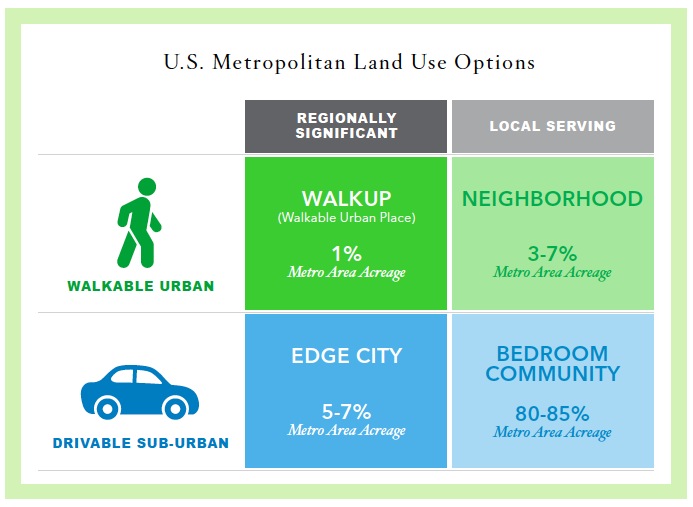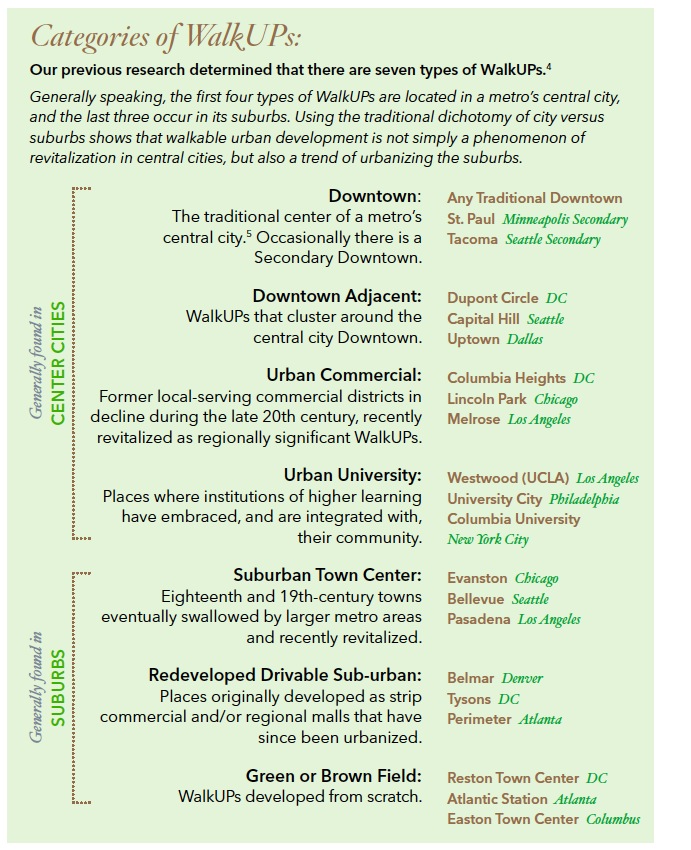SMART GROWTH AMERICA
Executive Summary
 This report indicates that metros found to have high walkable urbanism are models for the future development patterns of many—and possibly most— of the largest 30 U.S. metros.
This report indicates that metros found to have high walkable urbanism are models for the future development patterns of many—and possibly most— of the largest 30 U.S. metros.
These trends suggest future demand for tens of millions square feet of walkable urban development and hundreds of new WalkUPs.
This demand would provide an economic foundation for the U.S. economy, similar to the building of drivable suburbs in the mid to late 20th century.
Key Findings
- There are 558 WalkUPs, or regionally significant, walkable urban places, in the 30 largest metropolitan areas in the United States.
- The 30 metros are ranked according to their current walkable urbanism and categorized into four levels:
LEVEL 1: High Walkable Urbanism Metros that augur the end of sprawl, as their current development is concentrated in creating and expanding WalkUPs rather than drivable sub-urban areas.
LEVEL 2: Moderate Walkable Urbanism Metros that are developing both drivable sub-urban and walkable urban places, but are trending more toward a walkable urban future.
LEVEL 3: Tentative Walkable Urbanism Metros that are trending toward WalkUP development in their central cities—along with a few examples in suburbs— despite being dominated by drivable sub-urban patterns. - LEVEL 4: Low Walkable Urbanism Metros that continue to build in the drivable sub-urban pattern.Any brights spots of walkable urbanism tend to be located in revitalizing center cities.
- Future-oriented metrics show that some metropolitan areas, such as Miami, Atlanta, Los Angeles and Denver, are making some surprising and unexpected shifts toward walkable urban development.
- The most walkable urban metro areas have substantially higher GDPs per capita and percentages of college graduates over 25 years of age in the population.These relationships are correlations.Determining the causal relationships will require further research.
- Walkable urban office space in the 30 largest metros commands a 74 percent rent-per-square-foot premium over rents in drivable suburban areas.And, these price premiums continue to grow.
- Walkable urban development is not limited to the revitalization of center cities; it is also the urbanization of suburbs.
Introduction & Methodology
(Walkable) Urban Renewal
It is time for a new approach to urbanism and real estate analysis. With the rebirth of walkable urban development, we can no longer categorize metropolitan real estate as simply “city” or “suburb.”
Since 1950, metropolitan areas in the United States have been divided into the two broad U.S.Census categories of “central city” and “outlying counties,” many times referred to in the popular press as “urban” and “suburban.” New development patterns suggest this old dichotomy is less meaningful today.Now, the only reason to use the old dichotomy is to show how far we have moved beyond it.
A far more useful understanding of metropolitan1 America is “walkable urban” and “drivable sub-urban” development.Because both types of development can occur in a metro’s central city and in its suburbs, the old dichotomy is now obsolete.
During the second half of the 20th century, the familiar drivable sub-urban approach dominated real-estate development.Drivable sub-urban was characterized by low-density development connected only by car or truck, with real estate product types such as housing, office, industrial, and retail segregated from one another.
Most real estate developers and investors, government regulators, and financiers understood this model well, turning it into successful development formulas.In addition to real estate, this model fueled demand for automobiles and trucks, drove road construction, and supported the finance, insurance, and oil industries.In short, this development model provided a solid foundation for the U.S. economy throughout the mid- to late-twentieth century.
Walkable urban development is characterized by much higher density and a mix of diverse real estate types, connected to surrounding areas via multiple transportation options, such as bus and rail, bike routes, and motor vehicles.For those living or visiting a walkable urban place, everyday destinations, such as home, work, school, stores, and restaurants, are within walking distance.
Walkable urbanism is already a powerful driver of the economy, as shown by substantial downtown and suburban town center redevelopment, the redevelopment of regional malls into mixed-use developments, brown and green field walkable urban development, and the rise of the New Urbanism movement.This report will demonstrate that over the next generation, walkable urban development will spur even greater economic growth as demand for walkable urban development is met.The future growth of walkable urban places could provide the same economic base in the 21st century that drivable sub-urbanism did in the mid- to late-20th century.However, this growth will not be realized without appropriate infrastructure, zoning, and financing mechanisms at the federal, state, and local levels.
Two development forms dominate metropolitan development trends: walkable urban and drivable sub-urban.While each form includes a spectrum of densities, these two forms are fundamentally different, requiring different land acquisition, zoning, construction, financing, marketing, and management.
Download full version (PDF): Foot Traffic Ahead
About Smart Growth America
www.smartgrowthamerica.org
“Smart Growth America advocates for people who want to live and work in great neighborhoods. We believe smart growth solutions support thriving businesses and jobs, provide more options for how people get around and make it more affordable to live near work and the grocery store. Our coalition works with communities to fight sprawl and save money. We are making America’s neighborhoods great together.”
Tags: Downtown, Smart Growth America, Walkability, WalkUPs







 RSS Feed
RSS Feed